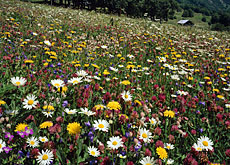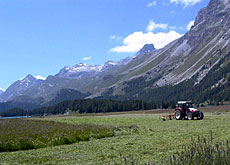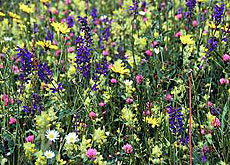Farmers could win from greater biodiversity

The positive effect of biodiversity on the ecosystem is far more profound than previously thought, according to a study carried out in part at Zurich University.
Crop yields could also be boosted by simply widening the range of farmland flora and fauna, one of the authors told swissinfo. A separate study in May warned that Swiss farming was destroying biodiversity.
The research carried out by scientists at Zurich and Oxford universities concludes that the impact of reduced biodiversity on food production, carbon dioxide levels and clean water supplies had previously been underestimated.
Previous studies looked at the impact plant and animal species had on individual “ecosystem services”, such as soaking up carbon dioxide. The new research, published this month in Nature magazine, found that several species influenced more than one service depending on how they interacted with other species.
Professor Andy Hector from Zurich University’s Institute of Environmental Sciences explained that any one service might share up to half the species involved in another beneficial environmental action.
“Previous assessments of the importance of biodiversity for ecosystems services might have underestimated the importance of biodiversity by looking at ecosystem services individually. When you take a broader view then you find that the amount of biodiversity needed is higher,” he told swissinfo.
Protecting the environment
Hector believes that the new-found knowledge could help farmers protect the environment without losing productivity. By combining more species on agricultural land, farmers could also benefit from ecological service, he explained.
“You can always have productive agriculture by adding artificial fertilisers or pesticides, but then there is the cost of the input and associated negative impact such as fertilisers polluting waterways. Our research suggests that by coming up with complementary sets of species you may be able to get a reasonable level of productivity without having to suffer the cost of nitrogen run-offs into nearby streams,” he said.
“What we are looking for is a win-win formula where you can have more extensive agriculture that is friendlier to insect and bird populations, and at the same time benefit from natural pest control in the form of predators eating pests on your crop.”
A report on Swiss agricultural policy published in May criticised subsidies for a decline in alpine plant and animal species since the mid-1990s. The authors suggested targeting direct payments towards projects that helped preserve biodiversity.
“The higher the biodiversity, the more services we can derive from a landscape. That can be protection against erosion, protection against natural hazards or cleaner water for example,” co-author Markus Fischer told swissinfo at the time.
Making hay
Hector said this need not result in financial losses for farmers. His studies concentrated on European grasslands, including one area in Lupsingen in Canton Basel land that is used for haymaking.
“The Swiss site was one that showed several relatively strong biodiversity responses. The experimental communities that had greater diversity of plant species were more productive and produced more hay crop each year. Every time we halved the level of biodiversity the hay crop was reduced by 80 grams per square metre on average,” he said.
Switzerland provided part of the funding for the European Union backed research project.
swissinfo, Matthew Allen in Zurich
Scientists estimate that between ten and 100 million plant and animal species now exist on the planet.
According to the World Conservation Union (IUCN), 27,000 species disappear worldwide every year and 24 per cent of mammal and 12 per cent of bird species are now critically endangered.
The Swiss signed the United Nations convention on biodiversity in 1994.
Biodiversity, or biological diversity, is the term for the variety of life and the natural processes of which living things are a part.
This includes :
– genetic diversity – diversity of genes within a species. There is a genetic variability among the populations and the individuals of the same species.
– species diversity – diversity among species in an ecosystem. The Alps are considered a “hotspot” of species diversity.
– ecosystem diversity – diversity at a higher level of organization, the ecosystem.

In compliance with the JTI standards
More: SWI swissinfo.ch certified by the Journalism Trust Initiative



You can find an overview of ongoing debates with our journalists here. Please join us!
If you want to start a conversation about a topic raised in this article or want to report factual errors, email us at english@swissinfo.ch.